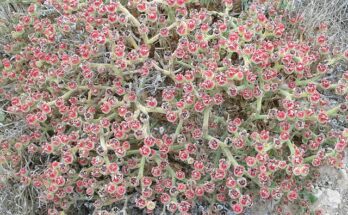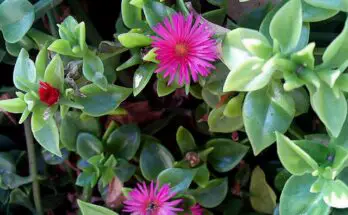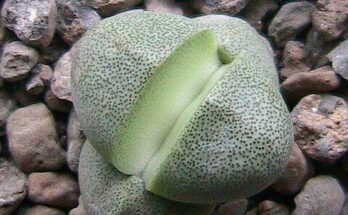Ice Plants, known scientifically as members of the Aizoaceae family, are a group of succulents renowned for their vibrant flowers and unique, water-storing leaves. These hardy plants are a favorite among gardeners and succulent enthusiasts for their easy care and stunning appearance. This article dives deep into the aspects of growing Ice Plants, including their types, propagation methods, ideal soil and pots, and answers to commonly searched questions.
Types of Ice Plants
There are several species of Ice Plants, each with its distinct features. The most common include the Delosperma Cooperi, known for its purple-pink flowers, and the Carpobrotus edulis, famous for its large, daisy-like blooms. Each species varies slightly in its care needs and growth habits, offering a range of options for gardeners.
Delosperma Cooperi
Delosperma Cooperi, commonly known as Cooper’s Ice Plant, is a standout with its purple-pink star-shaped flowers. This variety is particularly appealing to gardeners looking for vibrant ground covers.
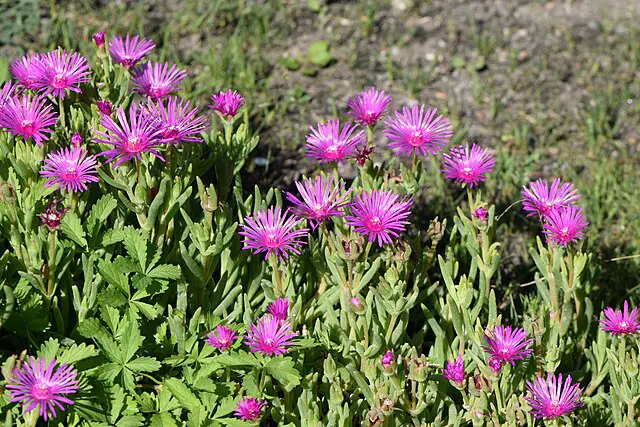
Its small, cylindrical leaves embody the classic succulent form, thriving in full sun and well-draining soils. Delosperma Cooperi has an extensive blooming period, from late spring to early fall, making it a favorite for adding long-lasting color to gardens. Remarkably drought-tolerant, it’s an excellent choice for dry, sunny climates and requires minimal maintenance.
Carpobrotus Edulis
Carpobrotus Edulis, often referred to as Hottentot-fig or Highway Ice Plant, is famous for its large, daisy-like flowers. These blooms range in color from sunny yellow to deep pink, set against the backdrop of thick, bluish-green triangular leaves.
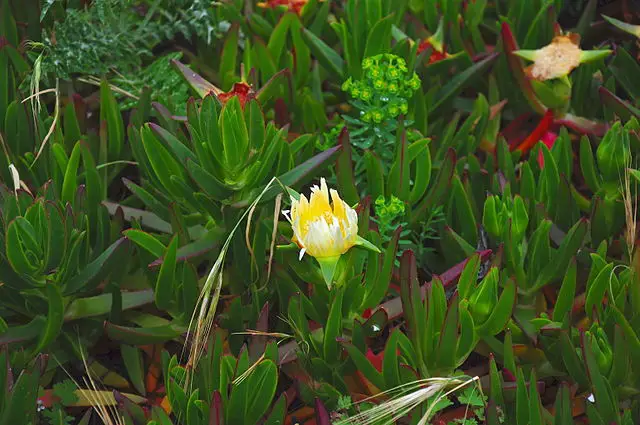
Flourishing in the spring and summer, it’s an ideal selection for adding a dramatic flair to your garden. Suited for sandy soils, this species is particularly tolerant of coastal conditions, including salt spray. It demands moderate watering and thrives in full sun, making it a robust choice for seaside gardens.
Lampranthus Spectabilis
The Lampranthus Spectabilis, or Trailing Ice Plant, is celebrated for its vivid, daisy-like flowers that come in an array of colors like pink, purple, red, and orange.
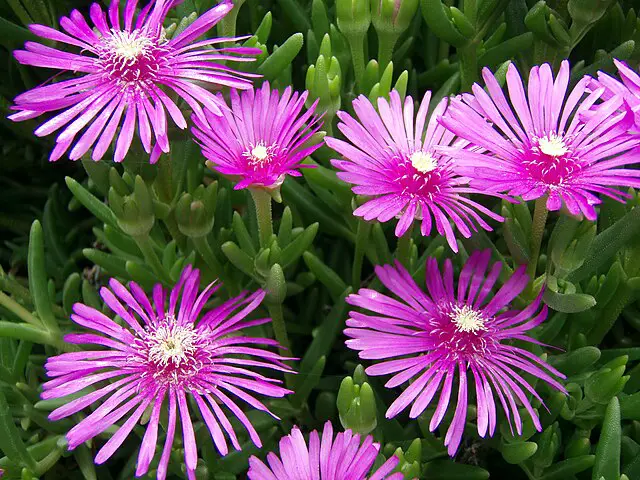
With small, needle-like leaves, this species creates a stunning carpet of color when in bloom during spring and early summer. It’s an exceptional ground cover plant and performs well in full sun and well-drained soil. Lampranthus Spectabilis is also a popular choice for container gardening, offering a cascading effect with its vibrant blooms.
Mesembryanthemum Crystallinum
Commonly known as the Common Ice Plant, Mesembryanthemum Crystallinum is unique for its crystalline leaves that sparkle as though frosted. Its small, daisy-like flowers bloom in summer, adding a subtle charm to its already intriguing foliage.
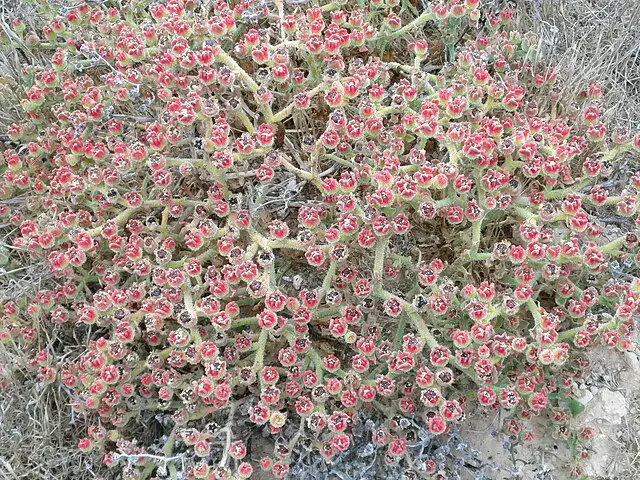
This species is a sun lover and thrives in poor, sandy soils. Its drought resistance is notable, making it a low-water requirement plant, ideal for xeriscaping or arid garden areas.
Aptenia Cordifolia
Aptenia Cordifolia, or Heartleaf Ice Plant, features glossy, heart-shaped leaves and bears small, bright pink or red flowers. It blooms prolifically throughout the warmer months, providing a continuous display of color.
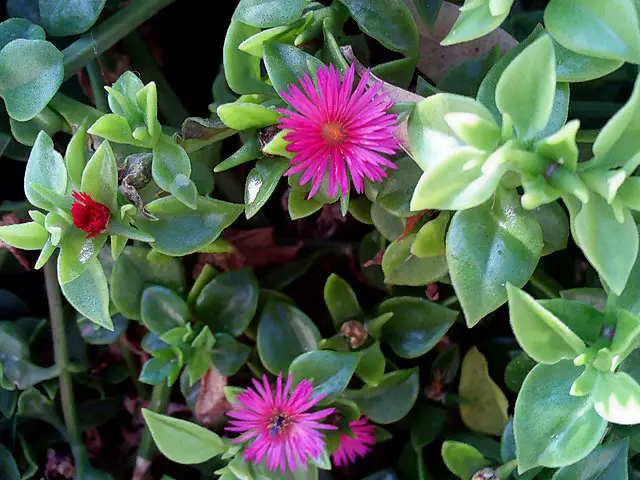
This species adapts well to a variety of sun conditions, from partial shade to full sun, and requires well-draining soil. Unlike other Ice Plant varieties, Aptenia Cordifolia can tolerate more humid conditions, making it a versatile choice for various garden environments. It’s also excellent for hanging baskets, where its trailing habit can be beautifully displayed.
Ice Plant Flowers
Ice Plant flowers are the show-stoppers of the garden. These dainty blossoms come in various colors, including shades of yellow, pink, purple, and orange. They typically bloom in the warmer months, adding a vibrant splash of color to your garden. The flowers not only enhance the aesthetic appeal but also attract pollinators like bees and butterflies.
Propagation of Ice Plants
Propagation of Ice Plants is a rewarding process, especially for beginners, due to its simplicity and high success rate. This process allows garden enthusiasts to multiply their beloved plants efficiently.
Propagation with Leaf Cuttings
Starting with leaf cuttings is a gentle introduction to Ice Plant propagation. The method begins by selecting a healthy leaf from the plant. The key is to ensure that the leaf is disease-free and robust. Once the leaf is plucked, it should be left to callous over for a day or two. This process involves letting the cut end of the leaf dry out, which helps prevent rot when planted.
After the callousing period, the leaf is ready to be placed on well-draining soil. This soil should ideally be a mix specifically designed for succulents, offering the right balance of drainage and nutrient retention. The leaf should rest on the soil’s surface without being buried. Watering plays a crucial role at this stage; the soil should be kept slightly moist but not waterlogged. In a few weeks, roots will start to develop from the base of the leaf, followed by new shoots, signaling the birth of a new plant.
Stem Cuttings
For those seeking a quicker propagation method, stem cuttings are the answer. This process involves cutting a healthy stem from the parent plant. It’s important to use a clean, sharp knife or scissors to make a clean cut, which helps the plant heal and root more efficiently.
Like leaf cuttings, the stem should be left to dry and callous over for about a day. This step is crucial as it prevents the stem from absorbing too much moisture and developing rot. Once calloused, the stem can be planted in well-draining succulent soil. Burying a small portion of the stem beneath the soil helps stabilize the cutting and encourages root growth. Watering should be done carefully; the soil should be allowed to dry out between watering sessions. This method tends to produce roots and new growth faster than leaf cuttings, making it ideal for those wanting to see quicker results.
Soil and Pots
Creating the ideal environment for Ice Plants begins with choosing the right soil and pot. These elements are fundamental in ensuring the health and longevity of the plants.
The Ideal Soil Mix for Ice Plant
Ice Plants thrive in well-draining soil, which prevents water from accumulating around the roots, thereby reducing the risk of root rot. A suitable mix often includes a combination of potting soil and materials like coarse sand or perlite. These additions improve drainage and aeration, providing the roots with the ideal balance of moisture and air. The soil should also be slightly acidic to neutral in pH, matching the natural growing conditions of Ice Plants.
Choosing the Right Pot
The choice of pot is as crucial as the soil. Pots with adequate drainage holes are essential to allow excess water to escape. Terracotta pots are a popular choice among Ice Plant growers due to their porous nature, which aids in evaporating excess moisture and keeping the soil environment balanced. Additionally, the size of the pot should be appropriate for the plant, offering enough space for growth but not so large that the soil remains wet for extended periods.
Watering: Balancing Moisture Needs
Watering is where most succulent gardeners go wrong. Ice Plants need a ‘soak and dry’ method. Water the plants thoroughly, then allow the soil to dry completely before watering again. In winter, reduce watering as the plants go dormant. Overwatering is a common issue, so ensuring good drainage and monitoring the soil moisture is key.
Growth and Spread
Ice Plants are known for their rapid growth and spreading habit. In ideal conditions, they can cover a wide area, making them excellent ground covers. However, it’s important to manage their spread to prevent them from overtaking other plants in your garden.
Common Questions
- Ice Plant Seed: Growing Ice Plants from seeds is possible but can be challenging. It requires a stable temperature and moisture level, making it less common than propagation from cuttings.
- How Fast Does Ice Plant Spread?: The spreading rate depends on the species and growing conditions. Generally, they can spread quite quickly, especially in warm, sunny environments.
Ice Plants are a versatile and visually appealing addition to any garden. With proper care, including appropriate soil, watering, and propagation techniques, they can thrive and add a vibrant touch to your outdoor space. Whether you are a seasoned gardener or a succulent newcomer, Ice Plants offer an enjoyable and rewarding gardening experience.


